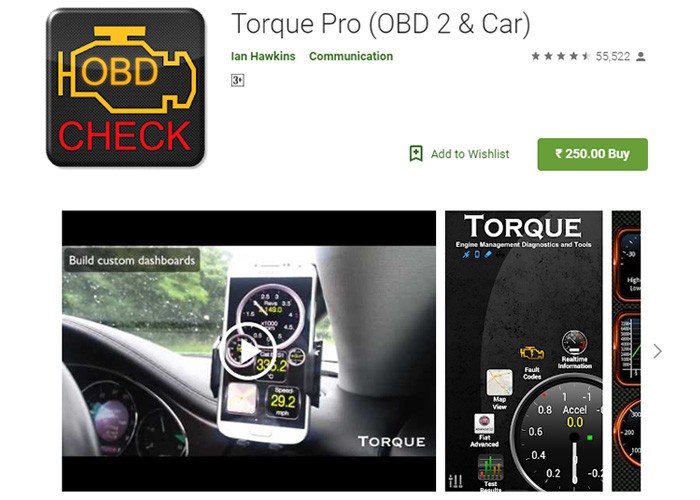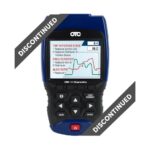In today’s world, understanding your vehicle’s health and performance is more accessible than ever, thanks to On-Board Diagnostics II (OBD2) apps. With the rise of sophisticated mobile app development, numerous applications are now available that tap into your car’s computer, offering real-time insights into its operation. For those keen on maximizing fuel efficiency, Obd2 Fuel Consumption Apps are proving to be invaluable tools.
These apps connect to your car’s OBD2 port, typically located under the dashboard, and provide access to a wealth of data, from engine speed and temperature to fuel consumption rates. This information empowers drivers to monitor their driving habits, identify areas for improvement, and ultimately save money at the pump.
However, the sheer volume of OBD2 apps in the market can be overwhelming. Choosing the right obd2 fuel consumption app for your Android or iOS device can feel like navigating a maze. Many users have also encountered apps that fail to deliver on their promises, leading to frustration and wasted expenditure.
To prevent you from falling into this trap, we’ve compiled a list of the top OBD2 apps, focusing specifically on their fuel consumption monitoring capabilities. Whether you’re a seasoned car enthusiast or simply looking to improve your gas mileage, this guide will help you select the perfect obd2 fuel consumption app to optimize your driving and save money.
Let’s dive in and explore the best OBD2 apps that can help you become a fuel-efficient driver!
Best OBD2 Apps for Fuel Consumption Monitoring
1. Torque Pro (OBD2 & Car)
Torque Pro is a highly acclaimed OBD2 app for Android, often praised as the best in its category, with over 1,000,000 downloads. While it requires a purchase of around $5 on the Play Store, user reviews consistently highlight its value, especially for drivers interested in detailed vehicle data and fuel efficiency.
Image: Torque Pro app dashboard displaying customizable gauges and real-time vehicle information, ideal for monitoring fuel consumption.
Torque Pro offers a customizable dashboard that displays real-time vehicle data, including crucial parameters for fuel consumption analysis. Users can monitor their Miles Per Gallon (MPG), fuel rate, and other fuel-related metrics directly on their mobile screen. The app also allows data export to servers or email for later analysis, enabling long-term tracking of fuel efficiency improvements.
Pros:
- Customizable dashboard with multiple themes to visualize fuel consumption data effectively.
- Real-time MPG and fuel rate readouts for immediate feedback on driving habits.
- Data logging and export capabilities to track fuel efficiency over time.
- Graphing tools to analyze fuel consumption patterns.
- Trip recorder feature can help correlate driving routes with fuel usage.
- Supports alarms and warnings, which can be configured for inefficient fuel consumption levels.
Cons:
- Requires a paid purchase upfront.
- Some users have reported Bluetooth pairing issues, although updates usually resolve these.
2. OBD Auto Doctor
OBD Auto Doctor is another versatile OBD2 app compatible with ELM327 Bluetooth and WiFi adapters. It excels in tracking essential vehicle sensors and parameters in real-time, with a strong emphasis on fuel consumption monitoring.
Image: OBD Auto Doctor app interface showcasing real-time fuel consumption data and vehicle diagnostics.
This app is particularly beneficial for drivers looking to save money on fuel, as its fuel consumption parameter monitoring is highly optimized. OBD Auto Doctor provides real-time data on fuel efficiency, allowing users to adjust their driving style to minimize fuel usage during trips.
Pros:
- Real-time fuel consumption monitoring displayed numerically and graphically for easy understanding.
- Optimized fuel consumption parameter tracking to help save money on gas.
- Compatible with all OBD2 compliant vehicles, ensuring broad usability.
- Data export via email in CSV format for detailed fuel consumption analysis.
- Customizable dashboard to prioritize fuel-related parameters.
Cons:
- Some features are locked behind in-app purchases or a Premium upgrade.
- Occasional connection issues or inaccurate readings have been reported by some users.
3. InCarDoc Pro
InCarDoc Pro has consistently ranked among the top OBD2 apps for car diagnostics and fuel monitoring. Its user-friendly interface and robust features make it a strong contender for drivers focused on fuel efficiency.
Image: InCarDoc Pro app main screen showing vehicle parameters and diagnostic information, including potential fuel economy data.
The app offers a free version to test compatibility before purchasing the Pro version for full functionality. InCarDoc Pro supports ELM327 USB, Bluetooth, and WiFi adapters and is compatible with most modern Android devices. Its fuel economy widgets and overlay display are particularly useful for real-time MPG monitoring while driving.
Pros:
- Real-time engine and vehicle parameters, including fuel consumption, displayed clearly.
- Fuel economy and acceleration widgets for quick access to fuel efficiency metrics.
- Overlay display to monitor fuel economy data in the background or over other apps like navigation.
- Data reporting and sharing capabilities for tracking and analyzing fuel consumption trends.
Cons:
- Requires Android 4.0.3 and up.
- Some users have experienced Bluetooth connection errors.
4. Car Scanner ELM OBD2 App
Car Scanner ELM OBD2 App is a free car diagnostic tool that stands out for its comprehensive monitoring capabilities and fuel consumption statistics. With over 2 million installs across various platforms and a high user rating (4.7), it’s a popular choice for drivers seeking detailed vehicle information, including fuel efficiency data.
Image: Car Scanner ELM OBD2 App customizable dashboard displaying various vehicle parameters, potentially including fuel consumption.
This app provides fuel consumption statistics directly on its customizable dashboard, allowing users to track their MPG and fuel usage patterns. Understanding these patterns can help drivers optimize their routes and driving habits for better fuel economy.
Pros:
- Free to use with fuel consumption statistics available.
- Customizable dashboard to prioritize fuel-related parameters for easy monitoring.
- Compatible with a wide range of OBD2 standard vehicles and ELM327 adapters.
- Settings backup and restore feature for convenient app management.
Cons:
- Requires Android 4.3 and above.
- In-app purchases are available for enhanced features, but basic fuel consumption tracking is free.
5. EOBD Facile
EOBD Facile is a user-friendly OBD2 car diagnostic app for both Android and iOS, supporting ELM327 WiFi and Bluetooth adapters. It provides real-time tracking of essential vehicle parameters, including those relevant to fuel consumption, making it a valuable tool for economy-conscious drivers.
Image: EOBD Facile app interface displaying real-time vehicle gauges, which can be configured to show fuel consumption data.
The app displays vehicle speed, engine RPM, engine temperature, and other gauges, depending on your car’s ECU capabilities. These parameters can be used to infer and monitor fuel consumption indirectly, allowing users to understand how driving habits affect fuel efficiency.
Pros:
- Real-time display of vehicle sensors, which can include fuel-related parameters.
- Trip record storage on SD card for later review and fuel consumption analysis.
- Route planning feature, which can be combined with fuel data to optimize routes for economy.
Cons:
- May require some prior OBD2 app experience to fully utilize its features.
- Does not support USB adapters.
6. HobDrive
HobDrive is a premium OBD2 app for Android, known for its advanced car tracking features and compatibility with both OBD2 and some non-OBD2 vehicles. While it’s one of the more expensive options, its comprehensive features justify the cost for users serious about vehicle monitoring and fuel efficiency.
Image: HobDrive app dashboard showing customizable gauges and real-time vehicle metrics, including potential fuel economy parameters.
HobDrive excels in fuel consumption calculation, even for diesel vehicles without direct battery help. It estimates MPG and provides clear explanations of fuel trims, helping users understand and optimize their fuel efficiency.
Pros:
- Customizable dashboard to display key fuel consumption parameters.
- Accurate MPG calculation, even for diesel vehicles.
- Tracks fuel trims and identifies potential fuel inefficiency issues.
- Supports GPS and ELM327 Bluetooth and WiFi adapters.
Cons:
- Higher price point compared to other OBD2 apps.
- Compatible with Android version 3 and above.
11. DashCommand (IOS)
DashCommand is a highly regarded OBD2 scanner app for iOS, recognized for its advanced engine data display and performance gauges. While it comes with a higher price tag ($14.99 on iTunes), its features and performance make it a worthwhile investment for iOS users focused on comprehensive vehicle monitoring, including fuel efficiency.
Image: DashCommand app showcasing advanced gauges and vehicle data, including fuel economy metrics, on an iOS device.
This app offers customizable performance gauges, including fuel economy gauges, allowing users to track MPG and fuel consumption in real-time. Its trip computer feature maintains fuel efficiency statistics for up to five trips, enabling detailed analysis of driving habits and fuel usage.
Pros:
- Customizable performance gauges to track preferred fuel efficiency data.
- Sophisticated trip computer to maintain fuel consumption stats for multiple trips.
- Data logging and recording capabilities for in-depth fuel efficiency analysis.
- Graphical representation of collected fuel data for easier understanding.
Cons:
- Higher cost compared to many other OBD2 apps.
- In-app purchases may be required for some car models.
17) OBD Fusion
OBD Fusion, developed by OCTech, is a popular OBD2 app for both iOS and Android, known for its user-friendliness and comprehensive diagnostic reports. Its customizable dashboards and extensive data logging capabilities make it a strong contender for users interested in monitoring fuel consumption and overall vehicle performance.
Image: OBD Fusion app customizable dashboard interface, highlighting its ability to display various vehicle parameters, including fuel consumption metrics.
OBD Fusion’s selling point is its ease of use, making it suitable for both beginners and experienced users. The customizable dashboard allows drivers to prioritize fuel consumption parameters, providing a clear and focused view of their fuel efficiency.
Pros:
- Customizable dashboards to display preferred fuel consumption data.
- Compatible with both iOS and Android platforms.
- Extensive data logging capabilities for detailed fuel consumption analysis.
- User-friendly interface suitable for both novice and experienced users.
Cons:
- Some features are locked behind expansion packs.
- Lacks diagnostic data sharing features.
Choosing the Right OBD2 Fuel Consumption App
Selecting the best obd2 fuel consumption app depends on your individual needs and priorities. Consider these factors when making your choice:
- Compatibility: Ensure the app is compatible with your smartphone operating system (Android or iOS) and your vehicle’s OBD2 protocol. Most apps list compatible vehicles or OBD2 protocols on their websites or app store descriptions.
- Features: Evaluate the app’s fuel consumption monitoring features. Does it offer real-time MPG readings, fuel rate, trip statistics, and data logging? Do the features align with your fuel efficiency tracking goals?
- Ease of Use: Look for an app with a user-friendly interface and customizable dashboards. A clear and intuitive app will make it easier to monitor fuel consumption data while driving.
- Price: OBD2 apps range from free to premium paid options. Free apps may offer basic fuel consumption monitoring, while paid apps typically provide more advanced features and detailed data analysis. Consider your budget and the level of features you require.
- Adapter Compatibility: Most apps are compatible with ELM327 Bluetooth or WiFi OBD2 adapters. Ensure the app you choose works with readily available and reliable adapters.
Conclusion
OBD2 fuel consumption apps are powerful tools for drivers looking to save money on fuel and drive more efficiently. By providing real-time insights into your vehicle’s fuel usage, these apps empower you to make informed driving decisions and optimize your fuel economy.
Before committing to a paid app, take advantage of free “lite” versions or trial periods to test compatibility with your car and ensure the app meets your needs. By carefully selecting the right obd2 fuel consumption app, you can unlock valuable data, improve your driving habits, and enjoy significant fuel savings over time. Choose the app that best fits your vehicle and your driving style, and start driving smarter today!

